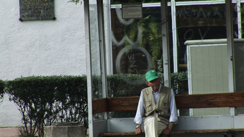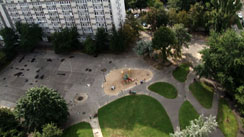Home / / Photo / Sculptures / Curatorial Projects / Bio / Contact
![]()

![]()

![]()

![]()
> stills and quotes
![]() > view excerpt
> view excerpt
A Portrait of an Estate, Gabriela Switek
In 1989 the Berlin Wall fell and with it the existing political and economic system. In countries formerly behind the Iron Curtain socialistic architecture remained, estates made up of huge blocks, now referred to as “unwanted heritage.” The Warsaw Za Zelazna Brama estate is an example. It was designed for 25,000 inhabitants in 1961 by Jan Furman, Jerzy Czyz, Jerzy Jozefowicz and Andrzej Skopinski (constructed: 1965-1972). Nineteen massive blocks are situated in equal distances from each other, perpendicularly to the Saska Axis laid out during the reign of King August II the Strong. The name of the estate refers to the Zelazna Brama Square and the non-existent gate that once was the western entrance to the Saski Garden. Neither the lay-out of the estate, nor its name, indicate directly that the settlement was the last urban project of the post-war reconstruction scheme on the grounds of the former ghetto.
In the early seventies the estate was a symbol of socialistic prosperity, social promotion and technological progress. It well matched the Polish road to socialism under Chairman Gomulka. In 1971 the Polish Film Chronicle immortalized the moment of moving into Za Zelazna Brama. The estate also served as a backdrop in Polish feature films such as Andrzej Wajda’s Hunting Flies (1969) and Stanislaw Bareja’s cult comedy Man – Woman Wanted (1971). Since 1989, the Za Zelazna Brama estate has been one of the busiest building sites, attracting western investors and has gradually been transformed into a Warsaw Manhattan. Planners have been observing a “spontaneous expansion of a business centre” west of Jana Paw?a II Avenue. Apart from office buildings, premises of insurance companies and exclusive hotels, enclaves of luxurious housing are being constructed. However, the days of glory of the blocks of communist Poland era are over. The buildings hardly ever undergo thorough revitalization and playgrounds have been taken over by estate car parks. However real estate agents still see good business in the sale of the low, cramped apartments with windowless kitchens and French windows instead of balconies. For them the Za Zelazna Brama Estate is like a Warsaw “China Town” due to a vast population of Vietnamese that resides there.
“The size and sameness of the estates have become their greatest faults – identical stairwells, identical corridors leading to hundreds of identical apartments fill the anonymous ‘ant-houses.’” The architect Andrzej Basista noted that the Polish tower block estates had led to “triple anonymity: estates in a city, buildings in estates and apartments in buildings. […] the space with which the tenants identify themselves ends at the doors of their apartments, they are however aware that they have no influence on what everything beyond their doors looks like” (Architecture. Why it is what it is, Krakow 2000). It is no coincidence that tower block estates have become the object of sociological research. From September to December 2009 a survey regarding day-to-day relations between neighbors was carried out. The project entitled We and Our Neighbors was initiated by the Centre for Migration Studies of the Warsaw University.
Heidrun Holzfeind’s film Za Zelazna Brama/Behind The Iron Gate (2009) falls into the artist’s interest in the history of modernistic architecture, typically blocks and tower block estates and social relations that are determined by the place of residence. The film Corviale, il serpentone (2001) is Holzfeind’s similar project. It is the story of a one kilometer long apartment block on the outskirts of Rome, housing 9,500 people, designed in 1972 and completed in 1983. Breaking the anonymity of the Za Zelazna Brama estate, the artist carried out conversations with the tenants who tell the story of their residence on the estate, she interviews caretakers, kiosk proprietors, porters, members of residents’ committees and ladies who clean the corridors in the blocks. Heidrun adopted the attitude not of an artist-ethnographer or sociologist, but rather that of an observer of daily life. She does not impose a ready-made set of questions or scientific methodology on her interlocutors. “Do you like these blocks”? – she asks some boys at a playground. “They’re ok” - says one boy. “I feel like in a cage; the apartments are small” – says another. The older residents of the estate reminisce that the apartments were the “luxury of their youth,” at one time the most expensive apartments in Warsaw, “palaces” in comparison with apartments in which people lived straight after the war. “I need nothing more, apart from a balcony” – says a lady who lives on her own.
A kiosk proprietor reminds us that many famous actors and intellectuals used to live on the estate. Nota bene - the kiosk and the main hall are the substitute for public space in the Za Zelazna Brama blocks – the only place where inhabitants get to know one another. The tenants often do not know their neighbors but instead the porter knows everyone: “one old lady brings me tripe soup and dumplings, I feel at home here.” Many tenants complain however that their block is a monstrosity, hotel, dormitory, that no one knows anyone, that the rooms are small and hard to arrange and that when it is hot outside, cooking in the windowless kitchens is a nightmare. One of the tenants points out that it is hard to bring up children here because the limited space causes aggression. Seeing the estate cannot be knocked down, maybe at least families with children could be prohibited and an estate for singles could be created.
From the outer world of panoramic views of the estate, the playgrounds, car parks, halls and corridors, Heidrun Holzfeind leads us into the interiors, uncovering the diversity of the private apartments that in an amazing way is in contrast to the uniform exteriors of the blocks. An elderly couple shows us around an interior that resembles a XIX century drawing-room or a museum chamber – portraits of Polish leaders hang among a huge collection of historical weaponry. As the owners put it the home was arranged to have “a Polish atmosphere.” A young couple talks about the thorough reconstruction their apartment underwent to receive a universal, minimalistic style. A boy from a Vietnamese family shows us his room and Vietnamese teenage girls talk about a neighbor who lacks a friendly attitude towards them. We also view an apartment of a Jewish family that stresses that it is convenient to live 15 minutes away from the Nozyki Synagogue (at 6 Twarda Street, built in the years 1898-1902 and renovated 1977-1983). We learn that many people come here in search of Isaak Bashevis Singer’s Krochmalna Street, only “that Krochmalna Street is gone.” A representative of the Jewish community praises the tranquility and calm of the estate and when asked about the remembrance associated with the place, he says that "the scar is there but you must not scratch because then it hurts.” Heidrun Holzfeind presents the estate through the stories told by its inhabitants and employees. She couples the panorama of the monumental tower block complex with the interiors that reflect the characters of the people living in them, she creates a collective portrait of a non-homogeneous community, the daily life of which is defined by the monotony of the blocks.
A home is not only the place we experience in the practice of everyday life or where we want to feel at ease and safe. A home is also the place that forms our desires and views, family and social ties. One of the aims adopted by architects of modernistic estates – although now this seems far from reality – was providing a safe and dignified shelter. Heidrun Holzfeind’s film Za Zelazna Brama raises however a new question regarding inhabitance: can one feel at home in a post-socialistic architectural environment defined by unfamiliar buildings.
Dr. Gabriela Switek, adjunct at the Art History Institute of the Warsaw University, graduate of the University of Cambridge Faculty of Architecture and History of Art (1999). Head of the Documentation Department of the Zacheta National Gallery of Art, curator of the Transfer exhibition in the Polonia Pavilion during the 10th International Architecture Exhibition in Venice. Author of Writing on Fragments: Philosophy, Architecture, and the Horizons of Modernity (2009).
read Grzegorz Piatek's full text in > English
-